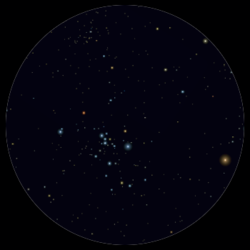KQ Puppis (KQ Pup) is a spectroscopic binary located about 2,700 light-years from Earth in the constellation Puppis. A red supergiant star and a B-type main-sequence star orbit each other every 27 years. Its apparent magnitude varies between 4.82 and 5.17, making it faintly visible to the naked eye.
The KQ Puppis system consists of a fairly typical M2 supergiant, in orbit with a hotter less luminous star. The hotter star is surrounded by a disc of material being transferred from the cool supergiant. This type of binary is referred to a VV Cephei system, although in this case there are no eclipses of either star.[8] A portion of the disc does appear to be eclipsed and this is detected as a strong drop in far-ultraviolet radiation for about a third of the orbit.[4]

The red supergiant primary star has been compared to Betelgeuse.[8] It shows small amplitude irregular pulsations, and also some variation associated with the orbital motion.[12] The nature of the secondary is less certain. The spectrum shows high excitation features that would indicate an early B or hotter spectral type, but these may be associated with the disc rather than that star itself. Other studies have found a spectrum similar to an A supergiant, but this is thought to be an artefact of a B-type shell star.[13]
KQ Puppis has been catalogued as an outlying member of the open cluster Messier 47 (NGC 2422) and would be the brightest member of that cluster.[14] Membership is uncertain as it appears to be more distant than the other stars in the cluster.[15]
References[edit]
- ^ a b Van Leeuwen, F. (2007). "Validation of the new Hipparcos reduction". Astronomy and Astrophysics. 474 (2): 653–664. arXiv:0708.1752. Bibcode:2007A&A...474..653V. doi:10.1051/0004-6361:20078357. S2CID 18759600.
- ^ a b c Ducati, J. R. (2002). "VizieR Online Data Catalog: Catalogue of Stellar Photometry in Johnson's 11-color system". CDS/ADC Collection of Electronic Catalogues. 2237: 0. Bibcode:2002yCat.2237....0D.
- ^ a b Samus, N. N.; Durlevich, O. V.; et al. (2009). "VizieR Online Data Catalog: General Catalogue of Variable Stars (Samus+ 2007-2013)". VizieR On-line Data Catalog: B/GCVS. Originally Published in: 2009yCat....102025S. 1: 02025. Bibcode:2009yCat....102025S.
- ^ a b c González-Riestra, R.; Rossi, C.; Viotti, R. F. (2003). "First far-UV observations of KQ Puppis with FUSE". Astronomy and Astrophysics. 399 (2): 681. Bibcode:2003A&A...399..681G. doi:10.1051/0004-6361:20021830.
- ^ Wilson, Ralph Elmer (1953). "General catalogue of stellar radial velocities". Washington: 0. Bibcode:1953GCRV..C......0W.
- ^ a b c Vallenari, A.; et al. (Gaia collaboration) (2023). "Gaia Data Release 3. Summary of the content and survey properties". Astronomy and Astrophysics. 674: A1. arXiv:2208.00211. Bibcode:2023A&A...674A...1G. doi:10.1051/0004-6361/202243940. S2CID 244398875. Gaia DR3 record for this source at VizieR.
- ^ Bailer-Jones, C. A. L.; Rybizki, J.; Fouesneau, M.; Demleitner, M.; Andrae, R. (2021-03-01). "Estimating distances from parallaxes. V: Geometric and photogeometric distances to 1.47 billion stars in Gaia Early Data Release 3". The Astronomical Journal. 161 (3): 147. arXiv:2012.05220. Bibcode:2021AJ....161..147B. doi:10.3847/1538-3881/abd806. ISSN 0004-6256. Data about this star can be seen here.
- ^ a b c d e f g h i j Rossi, C.; Altamore, A.; Baratta, G. B.; Friedjung, M.; Viotti, R. (1992). "The spectrum of the VV Cephei star KQ Puppis (Boss 1985). III - A possible model". Astronomy and Astrophysics. 256: 133. Bibcode:1992A&A...256..133R.
- ^ McDonald, I.; Zijlstra, A. A.; Boyer, M. L. (2012). "Fundamental parameters and infrared excesses of Hipparcos stars". Monthly Notices of the Royal Astronomical Society. 427: 343. arXiv:1208.2037. Bibcode:2012MNRAS.427..343M. doi:10.1111/j.1365-2966.2012.21873.x.
- ^ a b Tetzlaff, N.; Neuhäuser, R.; Hohle, M. M. (2011). "A catalogue of young runaway Hipparcos stars within 3 kpc from the Sun". Monthly Notices of the Royal Astronomical Society. 410 (1): 190–200. arXiv:1007.4883. Bibcode:2011MNRAS.410..190T. doi:10.1111/j.1365-2966.2010.17434.x. S2CID 118629873. KQ Puppis' database entry at VizieR.
- ^ "Hipparcos Tools Interactive Data Access". Hipparcos. ESA. Retrieved 8 December 2021.
- ^ Viotti, R.; Rossi, C.; Muratorio, G. (1998). "Optical and near-IR observations of variable stars with AURELIE". Astronomy and Astrophysics Supplement. 128 (3): 447. Bibcode:1998A&AS..128..447V. doi:10.1051/aas:1998156.
- ^ Parsons, Sidney B.; Ake, Thomas B. (1998). "Ultraviolet and Optical Studies of Binaries with Luminous Cool Primaries and Hot Companions. V. The Entire IUE Sample". The Astrophysical Journal Supplement Series. 119 (1): 83. Bibcode:1998ApJS..119...83P. doi:10.1086/313152.
- ^ Van Schewick, H. (1966). "Untersuchungen uber die Eigenbewegungen von Sternhaufen. XII. NGC 2422, NGC 2423, NGC 7209 und An. Bakhatova I im Sel. Area 40". Veroeff. Univ. Sternw. Bonn. 74: 1. Bibcode:1966VeBon..74....1V.
- ^ Baumgardt, H.; Dettbarn, C.; Wielen, R. (2000). "Absolute proper motions of open clusters. I. Observational data". Astronomy and Astrophysics Supplement. 146 (2): 251. arXiv:astro-ph/0010306. Bibcode:2000A&AS..146..251B. doi:10.1051/aas:2000362. S2CID 7180188.
